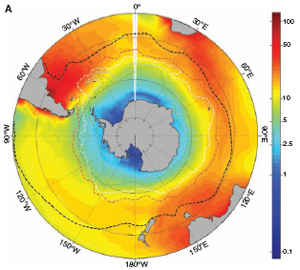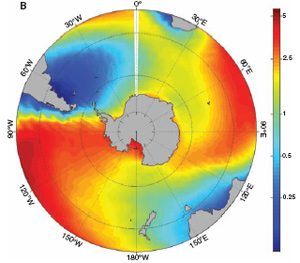Iron boosts carbon sequestration by the ocean
Wind-blown dust boosts biological productivity of ocean
mongabay.com
August 23, 2007
Wind-blown iron contributes significantly to the biological productivity of the Southern Ocean near Antarctica, researchers report in this week’s issue of the journal Science.
Combining previous data with new observations and computer simulations, scientists led by Nicolas Cassar of Princeton University show that net community production increases with natural aerosol iron deposition in the Southern Ocean. The results suggest that wind-blown dust — one of five sources of bioavailable iron to surface waters of the Southern Ocean — may have important climate implications.
“This iron deposition stimulates the ocean algae to convert carbon dioxide into organic carbon that may sink to ocean depths, potentially influencing the atmospheric carbon dioxide concentration,” according to a statement from Science.
The researchers say the results support previous research that linked greater iron delivery to lower levels of carbon dioxide during the ice ages. The findings could help scientists better predict ocean uptake of carbon dioxide in the future.

|
“Our study strengthens the case that aerosols are a significant source of iron for ecosystems in the Southern Ocean,” Cassar told mongabay.com. “We need to better understand human induced change in atmospheric dust transport because of its potential impact on ocean’s biological productivity,”
However, Cassar cautions that the research “does not bring any new insight into the efficacy of artificial iron fertilization in sequestering carbon dioxide.”
“It has been known for a while now that adding iron to some regions of the world’s oceans increases the production of organic carbon,” he continued. “Our study mostly focuses on the contribution of aerosols to biological productivity in the Southern Ocean. It does not add any new information about the response of marine ecosystems to artificial iron fertilization.”
Planktos, a U.S.-based firm, is using iron fertilization in an attempt to trigger a plankton bloom that will sequester carbon from the atmosphere. The company plans to sell carbon offsets based on the amount of carbon sequestered, but its plans have been widely condemned by environmental groups who say that scheme will do more harm than good and could put important ecosystems at risk. The U.S. government has also ruled that the experiment would violate ocean dumping laws.
CITATION: N. Cassar, M.L. Bender, B.A. Barnett, S. Fan, W.J. Moxim, H. Levy II, B. Tilbrook (2007) “The Southern Ocean Biological Response to Aeolian Iron Desposition.” SCIENCE VOL 317 24 AUGUST 2007
